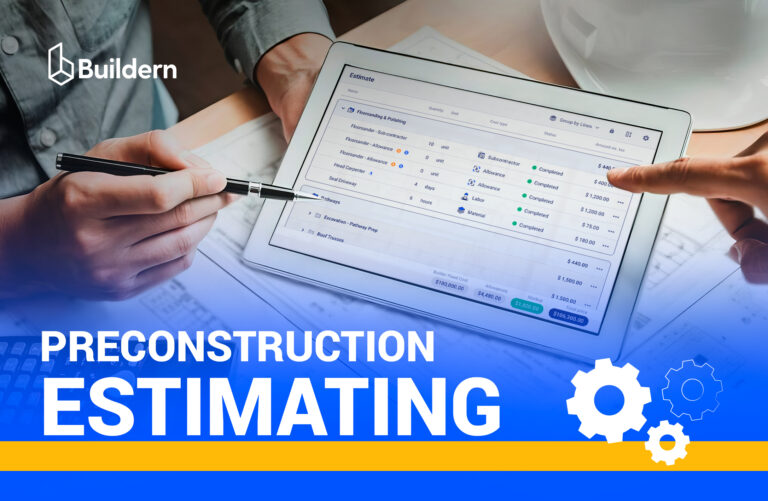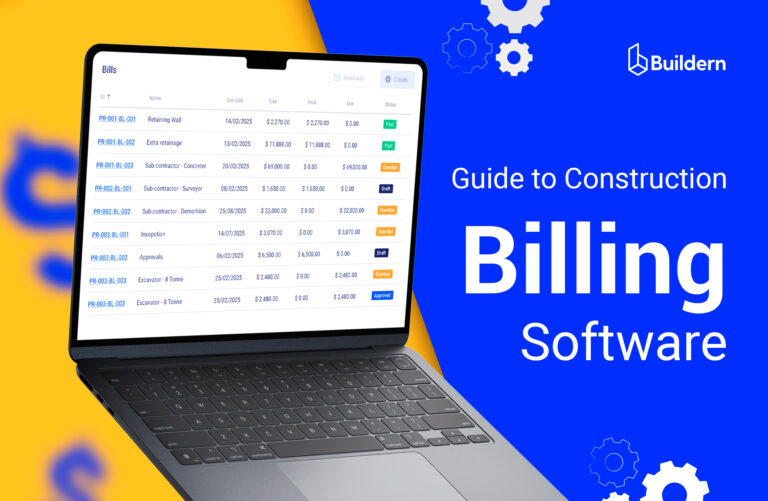Cash Flow Management in Construction: Everything You Need to Know

Did you know that 82% of construction companies failed not because of their profits, but due to improper cash flow management? And, it is not surprising that when cash does not come up on time to cover what is needed, the entire operation can start fluctuating, leading to failure. That’s why strategic cash flow management isn’t just important, it is crucial for the survival of your business.
In this article, we will explore what cash flow management in construction is, how to calculate it precisely, and what you can implement in your construction business to improve your cash flow.
Table of Contents
- What is Cash Flow Management and Why is it Important?
- Cash Flow VS Net Profit
- Types of Cash Flow
- How to Calculate Cash Flow in Construction?
- Benefits of Cash Flow Management in Construction
- Tips to Improve Cash Flow Management in Construction
- Final Thoughts

What is Cash Flow Management and Why is It Important?
Cash flow refers to the movement of your cash in and out of your construction business within a specific time frame. Proper cash flow management in place reflects the financial health and stability of your construction business. Positive cash flow showcases the surplus funds over your ongoing expenses, while negative cash flow indicates the opposite.
Steady cash flow is an important constituent of any construction business, and in many cases, unexpected missed or delayed payments can have devastating consequences. Appropriate cash flow management in place will help companies predict their needs, identify any shortfall, and take the necessary steps to help them grow their business.
Cash Flow VS Net Profit
There is a misconception among many entrepreneurs that gaining enough profits is what leads them to success. Yet in many cases, such companies fail in their business due to the negative cash flow. Confusing cash flow with net profit can lead to costly mistakes. While they both deal with money, they represent different aspects of construction finance. Therefore, understanding their differences is essential for keeping construction companies intact.
| Aspect | Cash Flow | Net Profit |
| Defintion | Cash movement (in and out) | Total income after all the expenses |
| Purpose | Ensures liquidity to cover the daily expenses of your project | Measures the long-term profitability and financial health of your business |
| Impact | Affects the ability to pay for all direct and indirect costs, including bills, suppliers, and staff. | Showcases the profitability and potential growth of your business. |
Cash flow: Cash flow is the accounting of the movement of your cash in and out of your construction business. Depending on the type of your project or your company’s size, it is possible to have a positive cash flow without much profit, or vice versa.
Net profit: Net profit, on the other hand, refers to the balance left after all expenses. It is a key metric of any construction company’s profitability, showcasing a company’s efficient use of resources, making it a vital indicator of its long-term success.
Types of Cash Flow
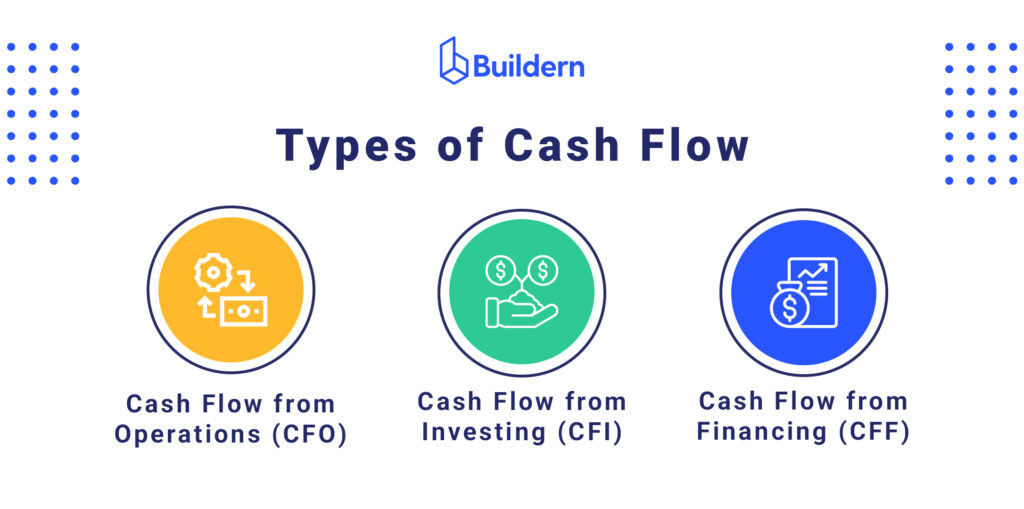
Managing the finances in the construction industry can be tough, especially if you’re managing multiple projects at once. Therefore, analyzing and categorizing your company’s cash movement correctly is a must-have skill. To simplify this process for you, we have outlined the three key cash flow categories, ensuring the strategic planning and financial control of your business.
Cash Flow from Operations (CFO)
This represents the money that comes from your company’s core business activities, which mainly includes the income from your projects and all the expenses associated with them.
Let’s assume that you are working on a construction renovation project, and you have reached the first milestone of your project. For the work you have already done, you have received $100.000 from your clients, but in the meantime, you have to pay the subcontractor $40.000 for the work they have already done. In this scenario, the difference between the $100.000 you received from your clients and the $40.000 you paid to your subcontractors is your positive cash flow from operations.
Cash Flow from Investing (CFI)
This refers to money received or spent on investments. It typically includes cash outflow from purchasing equipment, technology infrastructure, or vehicles, as well as cash inflow from selling equipment that is no longer in use. For instance, you might want to buy a $300.000 excavator to increase your earthwork capacity by 20%, which, as a long-term consequence, can lead to positive cash flow.
Cash Flow from Financing (CFF)
This is typically the cash received from loans, lines of credit, as well as the cash received that is used to cover debts or pay dividends. The cash flow from financing showcases how a construction business funds its operations, beyond its day-to-day income. For instance, you might opt for a $1.4 million construction loan with draw schedules aligning it to your project schedules.
However, it is essential to take into account that maintaining a healthy balance between financing and operational costs is essential in construction, and the opposite case may lead to unexpected project delays and budget overruns.

How to Calculate Cash Flow in Construction?
To calculate your cash flow, you need to come up with a cash flow forecast. There are a few important things to keep in mind when creating your cash flow forecast.
First, make sure you have clearly defined payment terms for both your clients and suppliers. This will ensure that you receive your payment in a timely fashion, plan your budget accordingly, and offer you legal protection.
It is equally important to develop estimates for internal project costs. Estimating your project’s internal costs is an important constituent, allowing you to predict how much money you will consume for your construction project over time. Be sure to include equipment cost, labor costs, material costs, and all the overhead costs associated with your project. To simplify this process for you, it is highly recommended to utilize an advanced construction estimating software for accurate project planning.
Finally, establishing a comprehensive project schedule plays a critical role in your cash flow forecasting success. You can utilize construction schedule management software like Buildern to make this process smoother for you. With its Gantt Chart feature, you can simplify your tasks, deadlines, and resources, making it a visually accessible timeline of your construction projects.
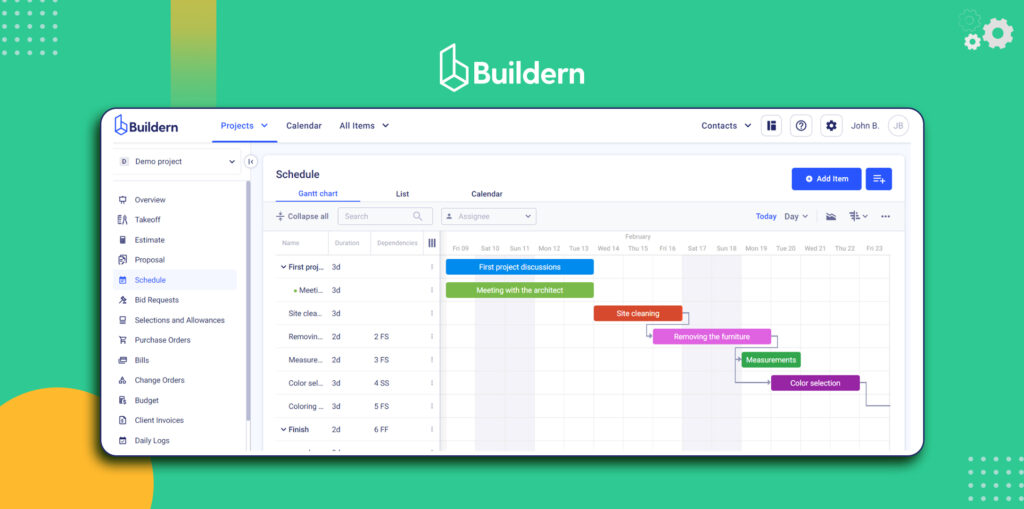
So, how do you actually calculate the cash flow once you’ve got your forecast ready?
Cash flow = cash inflows – cash outflows
Example: Let’s assume that the cash inflow of your construction project is $550.000 and the cash outflow is $510.000. In that case, your cash flow will be as follows:
$550.000 -$510.000 = $40.000
Benefits of Cash Flow Management in Construction
Cash flow management is extremely important and serves as the backbone of any business’s success. By equipping themselves with all the necessary knowledge about cash flow management in construction, companies can build a better and more profitable business model. Let’s explore some of the advantages that cash flow offers businesses.
- Consistent Project Progress: Effective cash flow management in construction directly contributes to consistent project progress. Managing your cash properly will ensure timely material procurement, regular payment to subcontractors and aborers, and equipment availability, which ultimately leads to continuous project progress.
- Better Financial Planning: According to research conducted by SCORE, approximately 82% of small businesses fail due to cash flow problems. Robust financial planning through effective cash flow management allows construction businesses to develop comprehensive budgets. With thorough financial planning, companies can also identify financial issues in advance, create contingency plans, and prevent budget overruns. Let’s assume
- Strong relationship with stakeholders: Effective cash flow management can foster a long-lasting relationship with project stakeholders. When construction businesses make their payments on time, follow their schedules accordingly without any hurdles or project delay, they ultimately build trust and reliability among their stakeholders. In the long run, this may lead to repeat business or valuable referrals.
- Operational efficiency: Properly managed cash flow can significantly improve the operational efficiency of your construction business. When all the financial resources are allocated properly and managed accordingly, it becomes easier to optimize material deliveries, preventing resource waste. This, as a consequence, may lead to a better operational efficiency.
Tips to Improve Cash Flow Management in Construction
Managing cash flow effectively can be really difficult, especially for such industry like construction. We have compiled the core tips and strategies that you should implement in your business to manage your cash flow effectively.
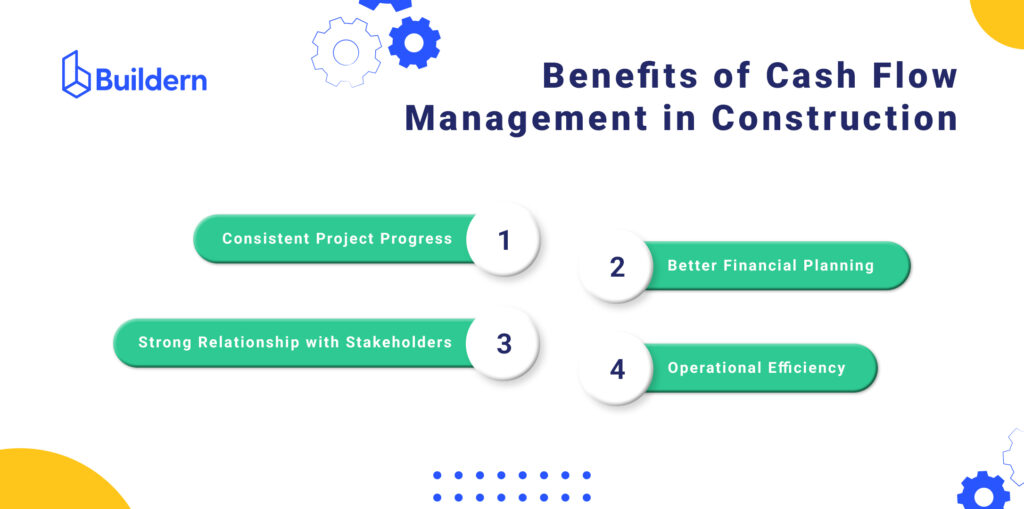
- Try Cash Flow Forecasting
Forecasting is perhaps one of the best ways to manage your cash flow. By constantly evaluating your incoming and outgoing cash, you can gain visibility into your financial position. As you implement cash flow forecasting into your business, you can immediately identify cash shortages before they even occur and take the necessary precautions to prevent them from happening. It also allows you to plan for growth opportunities by ensuring you have the necessary funds available when needed.
- Set Clear Payment Schedules
Having a transparent payment schedule with all your stakeholders is fundamental for your cash flow. Make sure to have milestone-based payment terms, since in most of cases construction projects involve multiple phases. This proactive approach will allow you maintain positive cash flow and mitigate the risk of project delays.

- Review your Budget
Review your budget periodically to maintain a positive cash flow throughout your entire project. Make sure to pay attention to both direct and indirect costs. Reviewing your budget constantly will allow you to make informed financial decisions and identify potential saving opportunities, which ultimately lead to positive cash flow. Regular budget reviews also help ensure that your project stays aligned with financial goals and prevent budget overruns that could compromise profitability.
- Send Automated Invoices
Sending automated invoices can drastically improve cash flow efficiency. This will minimize the amount of manual process, while also reducing the risk of delays. For Faster payments, you can also utilize construction invoice software. Such software will allow you to get paid faster, track and share your invoices with ease. Additionally, it enhances transparency with clients and streamlines communication, making it easier to resolve disputes or discrepancies quickly.
- Incentivise Clients to Pay Early
To have all your payments on time, incentivising clients to pay early can be a great strategy. You may opt for an option to offer your clients an early payment discount to motivate them to pay earlier. For instance, you could offer them a 15% discount if they make their payments within 10 days instead of 30. This not only improves your cash flow but also builds stronger client relationships by demonstrating flexibility and a willingness to reward prompt payments.
- Market Smarter, Not Harder
Don’t underestimate the power of construction marketing. The best way to bring in more money into your construction business is by bringing in more clients. Incorporate the right construction marketing ideas into your business. Consider social media, video marketing, email blasts, or optimizing your website. Utilize these low-budget marketing ideas for construction and see a high return on your business.
Final Thoughts
Effective cash flow management is the building block for construction projects. Given the complexity of the construction industry, its high upfront costs, and project durations, a well-managed cash flow in place will ensure project delivery on time and within budget. Implement the right cash flow management techniques and strategies. This will allow you to prevent the financial risks of your construction company and ensure the viability of your business.


